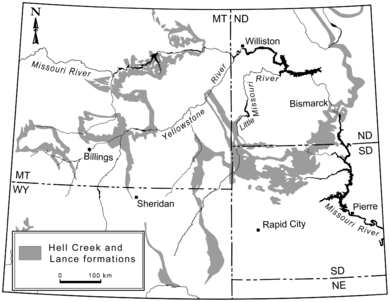Hell Creek Formation facts for kids
Quick facts for kids Hell Creek FormationStratigraphic range: Late Cretaceous to Early Paleogene, Maastrichtian–Danian (Lancian) ~68–66Ma |
|
|---|---|
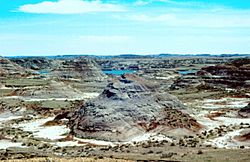
Exposure in the badlands near Fort Peck Reservoir
|
|
| Type | Geological formation |
| Unit of | Montana Group |
| Sub-units | Breien, Little Beaver Creek, Middle Sandstone & Pretty Butte Members |
| Underlies | Fort Union Formation |
| Overlies | Fox Hills Formation |
| Thickness | 50–100 m (160–330 ft) |
| Lithology | |
| Primary | Claystone, mudstone |
| Other | Sandstone, siltstone, conglomerate, amber |
| Location | |
| Coordinates | 46°54′N 101°30′W / 46.9°N 101.5°W |
| Approximate paleocoordinates | 52°36′N 74°24′W / 52.6°N 74.4°W |
| Region | Montana, North Dakota, South Dakota, Wyoming |
| Country | United States |
| Extent | Williston Basin |
| Type section | |
| Named for | Hell Creek, Jordan, Montana |
| Named by | Barnum Brown |
| Year defined | 1907 |
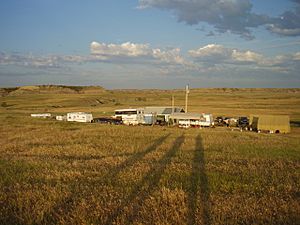
The Hell Creek Formation is a very famous rock layer in North America. It's named after Hell Creek, a place near Jordan, Montana, where these rocks were first studied. This important formation stretches across parts of Montana, North Dakota, South Dakota, and Wyoming. In Montana, it sits on top of another rock layer called the Fox Hills Formation.
The Hell Creek Formation is made up of clay, mudstone, and sandstone. These rocks were laid down by rivers and deltas at the end of the Cretaceous period and the start of the Paleogene period. This was a time when the Western Interior Seaway, a large ancient sea, covered much of central North America. The climate back then was warm and subtropical, with no long cold seasons. This is why we find fossils of crocodilians and palm trees.
One of the most important features of the Hell Creek Formation is the K-Pg boundary. This thin layer of rock marks the exact moment when the meteorite hit Earth, causing the extinction of the dinosaurs. This boundary is found near the top of the Hell Creek Formation. The world's largest collection of fossils from Hell Creek is kept at the Museum of the Rockies in Bozeman, Montana.
Contents
Ancient Earth: Hell Creek's Geology
The Hell Creek Formation is a significant rock layer that helps scientists understand Earth's past. In Montana, it lies above the Fox Hills Formation and below the Fort Union Formation. The line between the Hell Creek and Fort Union formations is very close to the Cretaceous-Paleogene boundary (K-Pg boundary). This boundary marks the end of the Cretaceous period and is dated to about 66 million years ago.
Scientists believe that the Hell Creek Formation, which is about 90 metres (300 ft) thick, was formed over about 2 million years. Fossils typical of the Hell Creek period are found just a few meters below this important K-Pg boundary.
In some areas, like North Dakota, the K-Pg boundary is found within the layer above Hell Creek, called the Ludlow Member of the Fort Union Formation. However, in small parts of Montana, the Hell Creek Formation itself contains the K-Pg boundary, meaning it extends slightly into the Paleogene period.
A special fossil site called Tanis in North Dakota shows amazing evidence of the meteorite impact. It has chaotic mixes of fossil animals and glass pieces (called tektites) that were deposited just minutes or hours after the impact.
Life in the Hell Creek Formation
The Hell Creek Formation is famous for the many animal and plant fossils found there. Because it was located where the land met the ancient sea, it has fossils of both land and marine creatures.
Hell Creek's Ancient Animals
Many different types of animals lived in the Hell Creek area. These include dinosaurs, pterosaurs (flying reptiles), crocodiles, lizards, snakes, turtles, frogs, and salamanders. Scientists have also found fossils of fish and small mammals. Even shark and ray teeth are sometimes found, showing that some of these ocean animals could live in fresh water too.
Some of the most famous dinosaurs found here are Tyrannosaurus and Triceratops. Other dinosaurs include ornithomimids (like ostrich-mimic dinosaurs), caenagnathids (like Anzu), pachycephalosaurs (dome-headed dinosaurs), and ankylosaurs (armored dinosaurs). The most complete hadrosaurid (duck-billed dinosaur) ever found, an Edmontosaurus, was discovered here in 2000.
Dinosaur Population in Hell Creek
Scientists have studied the Hell Creek Formation extensively to understand which dinosaurs were most common. Here's a breakdown of the most frequently found large dinosaurs:
- Ceratopsidae (like Triceratops): 40%
- Tyrannosauridae (like Tyrannosaurus): 24%
- Hadrosauridae (like Edmontosaurus): 20%
- Hypsilophodontidae (small plant-eaters): 8%
- Ornithomimidae (ostrich-like dinosaurs): 5%
- Ankylosauridae (armored dinosaurs): 1%
- Pachycephalosauridae (dome-headed dinosaurs): 1%
- Troodontidae (small, bird-like dinosaurs): 1% (mostly teeth)
- Dromaeosauridae (raptors): 1% (mostly teeth)
Triceratops was the most common dinosaur in all parts of the Hell Creek Formation. Surprisingly, Tyrannosaurus was found almost as often as Edmontosaurus. For example, in the upper part of the Hell Creek section, scientists found 22 Triceratops, 5 Tyrannosaurus, and 5 Edmontosaurus.
Other dinosaurs like Thescelosaurus, Ornithomimus, Pachycephalosaurus, and Ankylosaurus were also present but much rarer. The largest Triceratops skull ever found, nicknamed 'Dragon King', was discovered in Glendive, Montana, within this formation.
Eumaniraptorans: Ancient Raptors
Scientists have found many teeth from small, bird-like dinosaurs called Eumaniraptorans in the Hell Creek Formation. For a long time, these teeth were thought to belong to different types of raptors. However, a 2013 study suggested there might only be one main type of dromaeosaur (raptor) called Acheroraptor in this formation.
Later, in 2015, a new large dromaeosaur called Dakotaraptor was discovered, proving that more than one type of raptor lived here. Teeth from other small, bird-like dinosaurs like Paronychodon, Pectinodon, and Richardoestesia are also commonly found.
Hell Creek's Ancient Plants (Flora)
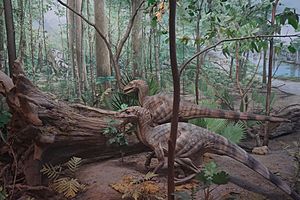
The Hell Creek Formation was once a low, wet floodplain covered in dense woodlands. It had a huge variety of flowering plants and conifers. The forest floor was home to many different herbaceous flowering plants, ferns, and moss. Along the edges of large rivers, there were shrubs and vines.
Evidence like petrified wood, ancient soils, and countless tree leaves shows that the area was heavily forested. The plant life was very different from today's. It included many types of dicots (flowering plants with two seed leaves), extinct cycadeoids, Ginkgo trees, various monocots, and several kinds of conifers.
About 90% of all plant fossils found are from flowering plants, making them the most common. Conifers make up about 5%, and ferns about 4%. Unlike the Great Plains today, which are mostly grasslands, Hell Creek was a hardwood forest with both deciduous (trees that lose leaves) and evergreen trees. The presence of palm trees and gingers shows that the climate was much warmer and wetter than it is now.
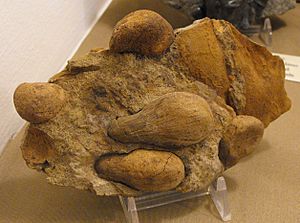
The plants of the Hell Creek Formation mostly formed forests along rivers. Scientists have divided the Hell Creek Formation into five zones based on changes in the plant life over time. This suggests that the global temperature was warming during the last 300,000-500,000 years of the Cretaceous period.
Interestingly, there is no evidence of modern grasses, oaks, maples, beeches, figs, or willows in the Hell Creek Formation. After the meteorite impact at the K-Pg boundary, there was a huge increase in fern spores, known as "the fern spike". This suggests that ferns were among the first plants to recover after the disaster.
Many of the plant names used today are similar to modern plants, but scientists are still figuring out if they are truly related. For example, it's not certain if modern Ficus or Juglans (walnuts) actually lived in the Late Cretaceous.
Most plant fossils from the Hell Creek Formation come from North and South Dakota. The Mud Buttes in North Dakota has the richest collection of plant fossils.
Overview of Hell Creek Plants (from Johnson, 2002): Scientists have identified 302 types of plants based on their leaves alone:
- 1 type of bryophyte (mosses and liverworts)
- 11 types of ferns
- 1 type of sphenopsid (like horsetails)
- 10 types of conifers
- 1 type of ginkgo (uncommon)
- 278 types of angiosperms (flowering plants), making up about 92% of all plants found.
- Plants of the Hell Creek Formation
- various ferns and cycadeoids
- Equisetum (Equisetaceae)
- Platyspiroxylon (Cupressaceae)
- Podocarpoxylon (Podocarpaceae)
- Elatocladus (Taxodiaceae)
- Sequoiaxylon (Taxodiaceae)
- Taxodioxylon (Taxodiaceae)
- Araucaria (Araucariaceae)
- Ginkgo adiantoides
- Artocarpus (Moraceae)
- Rose family (Rosaceae)
- Trochodendriodes (Cercidiphyllaceae)
- Penosphyllum (Sterculiaceae)
- Laurel family (Lauraceae)
- Magnolia (Magnoliaceae)
- Palms (Arecaceae)
- Platanites, sycamore or plane tree (Platanaceae)
Images for kids
-
View of Hell Creek State Park, the "heart" of Hell Creek Formation
-
The dominant plants of the Hell Creek Formation are mainly flowering plants
-
Ginkgo (uncommon)
-
Various angiosperms
-
Monkey-puzzle leaves
-
Palm trees indicate a hotter paleoclimate
-
Redwood seed cones
-
Magnolia (common)
See also
 In Spanish: Formación Hell Creek para niños
In Spanish: Formación Hell Creek para niños
- List of fossil sites (with link directory)
- Lists of dinosaur-bearing stratigraphic units
- Morrison Formation
- Cretaceous-Paleogene formations
- Denver Formation
- Ferris Formation
- Lefipán Formation, Argentina
- Lopez de Bertodano Formation, Antarctica
- Tremp Formation, Spain


